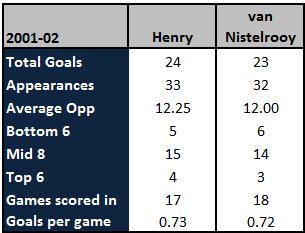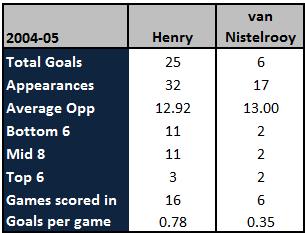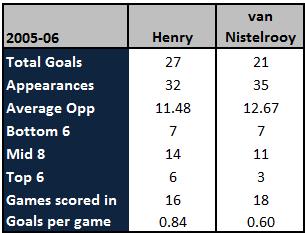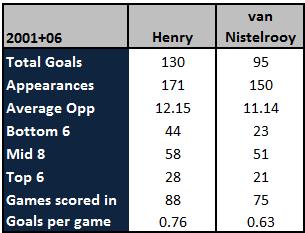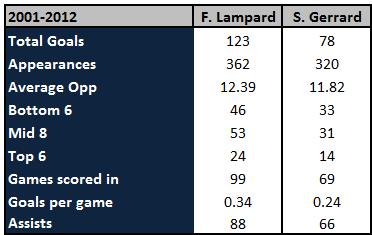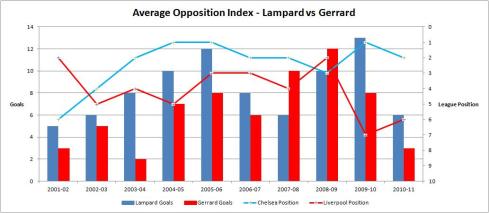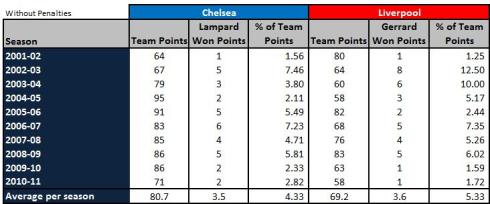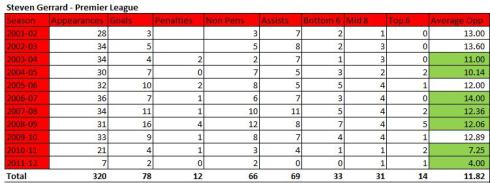Hot on the heels of the Lampard vs Gerrard comparison, the third in the series is another of the Premier League’s most discussed duos – Thierry Henry and Ruud van Nistelrooy. For the 5 years, that they both played in the Premier League they dominated the goalscoring charts with five winners, three runners up and one 3rd place in the race for the golden boot. But who was the bigger game player?
The Contenders:
Premier League:
2002-2003:
2003-2004:
2004-2005:
2005-2006:
Premier League Conclusion:
Just looking at the Premier League goals, it’s a 3-1 win to Henry in the 5 seasons.
Once again, it’s a win for Thierry – he has more goals, a better AOI of 50.98 vs van Nistelrooy’s 61.11 and is ahead on Top 10 opposition goals. Whilst he didn’t score in the two biggest international games of his career – World Cup final 2006 and European Champonships Final 2004, he has done it against big teams. Goals against Portugal, Germany, Brazil, Italy and Holland points to the fact that he can do it against the best, indeed the winner vs Brazil in the 2006 quarter finals is undoubtedly a big game goal.
For Holland, van Nistelrooy has a disappointing 3 goals versus the upper echelons of Footballing nations. His best moments for Holland came in Euro 2004 when he scored 4 goals – against Germany, Czech Republic and a brace against Latvia.
When looking at their big game credentials, it’s worth taking into account a few more details that aren’t easily comparable as the opponents aren’t ranked, and differ. In the Champions League, Henry has a medal with Barcelona, but again, failed to score in both the 2009 final, and the defeat for Arsenal in 2006. Ruud van Nistelrooy has 3 top scorer awards in the competition, and is second only to Raul in the all time European Cup scorers list. Guess who’s in 3rd? Thierry Henry of course.
BUT.
He may rate as a big game player in the Premier League, and indeed he had his moments in Europe – a hat trick at Roma, a brace in the San Siro and the winner against Real Madrid showed this, however, no goals from the below games unfortunately excludes him from joining the greats:
Cheers,
Liam
Henry getting away with another blatant handball
The Contenders:
France and Arsenal’s all time leading scorer, the man who brought va va voom to the Premier League and who is one of the most unpopular players in Ireland, Thierry Henry. Signed from Juventus after a less than convincing spell, Henry won 2 league titles and 3 FA Cups with the Gunners before moving on to Barcelona. On the Oranje side is Holland and Man United’s Ruud van Nistelrooy. Ruud has top scored in the Champions League 3 times, as well as golden boots in the Dutch, English and Spanish league. He moved on to Real Madrid in 2006 after winning 1 Premier League title, an FA Cup and a League Cup.
The Background:
Henry began his football career at Monaco under the tutelage of his future Arsenal manager Arsene Wenger. Initially played on the wing, he was eventually moved up front. He made his professional debut in August 1994 – going on to make 141 appearances for Monaco and scoring 28 goals in all competitions. He made his France debut in 1998 and went on to win the World Cup that same year, and earning a big move to Juventus. Henry struggled to make an impact with the Old Lady (I wonder would Wayne Rooney thrive there?) and found himself back out on the wing. After 3 goals in 19 appearances, Henry was reunited with his first manager in North London. It’s fair to say his strike rate improved with 46 goals in his first 100 games for the Gunners – taking us up to the summer of 2001.
Ruud van Nistelrooy had to overcome several hurdles at PSV
Ruud van Nistelrooy’s early career wasn’t quite as glamorous. He started his professional career with Dutch minnows Den Bosch. Like his French rival, he also started out as a midfielder but was moved to centre forward early on. He made his debut in 1993 and went on to score 20 goals in 71 appearances for them. His form in 1996-97 caught the eye of Heerenveen who shelled out €360k on the Dutch thoroughbred. His stay with them was a short one – his goalscoring record secured a move to Dutch giants PSV Eindhoven (for €6.3m – a tidy profit). It was here that his career really took off, scoring an impressive 71 goals in 95 games for the Eindhoven club. A move to Manchester United was all but tied up in 2000, but a serious knee ligament injury delayed it for a year.
The Rules:
As per usual, it’s primarily a comparison of their Premier Leauge goals rather than all goals. Why? Because they played against the same opposition over the same time period – and these opponents are ranked, meaning that we can calculate an average. International goals will also be taken into account. The time scale is the 5 year period from 2001-2006, from when van Nistelrooy joined, to when he left.
Premier League:
2001-2002:
And so on to the stats, their first season head to head was Henry’s 3rd in the league, and van Nistelrooy’s first. With that in mind, it’s particularly impressive the impact that the Dutchman had, and just how close he ran Henry for the Golden Boot. Henry played one game more and scored 24 goals to van Nistelrooy’s 23. Their goals per games tally were virtually identical – 0.73 vs 0.72. Who did it in the big games?
Well once again it was very close. Henry scored 4 against Top 6 opponents on his way to winning the league title with Arsenal. Chelsea (6th), Man Utd (3rd, two goals) and Liverpool (2nd) were all victims to his goalscoring touch. On the other side, van Nistelrooy scored in both games against 4th placed Newcastle, and once against Chelsea. From an average opposition point of view, the Dutchman edges it with an average opponent per goal of 12th place compared to Henry’s 12.25.
Winner: A Draw
Too tight to call this one, so a draw. An incredible debut season for Ruud, whilst Thierry stepped up to score over 20 league goals for the first time in his career. Henry had 4 against the Top 6 (one pen), whilst van Nistelrooy had a better average. This is just based on goals scored – Henry provided more assists by far, but this comparison is just on the goals….for now.
van Nistelrooy’s only title came in 2003
2002-2003:
Round 2, and after Arsenal won the title in 2001-02, Man Utd were out for revenge. And revenge they found. Powered by van Nistelrooy’s goals, United won the Championship, in what would be the Dutchman’s only Premier League title.Once again, they were pretty much neck and neck in terms of goals scored, this time van Nistelrooy winning the Golden Boot by one goal. He did it in 3 games less, taking his goals per game to an impressive 0.74 to Henry’s 0.65.
And they’re not the only stats that he wins on. His Average Opposition Index (AOI) was a very impressive 9.28, compared to the French hitman’s 12.25. The driver behind the AOI was a whopping 8 goals vs Top 6 opposition. On their way to the title, van Nistelrooy scored against 3rd placed Newcastle (4 goals including a hat trick in a 5-3 win), Blackburn Rovers (6th), Liverpool (2 goals) and most importantly, against title rivals Arsenal. In comparison, Henry scored 5 goals against the Top 6 teams, including both goals against United in a 2-2 draw.
Winner: Ruud van Nistelrooy
Although the number of goals were once again similar, the AOI and goals against Top 6 were heavily weighted in his favour.
2003-2004:
In what was an historic season, Arsenal would once again take the crown of Premier League Champions from United but this time would go the whole season unbeaten. Not only was this Arsenal’s greatest season, it was also Henry’s best in the League with 30 in 37 (0.81 goals per game). Ruud van Nistelrooy hit 20 league goals for the 3rd season running, but was way behind his rival.
Once again, it was the Dutchman who had the best AOI rating with 10.6 compared to Henry’s 11.93 but that was the only area he bettered Henry who smashed in 10 goals against the Top 6 (in a maximum of 10 games). Once again for the 3rd season running, he scored against United, this time in a 1-1 draw, whilst the highlight was a Hat trick against Liverpool in a game where his team was behind twice.
Winner: Thierry Henry
Ahead in goals and against Top 6 opponents. Inspired his team to go the season unbeaten on the way to winning the league. Sadly for Arsenal fans, their last at the time of writing. Ironically, van Nistelrooy could have ended the unbeaten streak, but missed a penalty in a 0-0 draw – much to Martin Keown’s delight.
2004-2005:
And so after 7 years of what seemed like Man Utd vs Arsenal for the title, Chelsea and Mourinho took over. In terms of the Player Comparison, this season was a write off for van Nistelrooy, with injury and form going against him. Just 6 goals, 3 of which were penalties, were scored in his 17 League appearances. On the other hand, Henry continued his impressive form with a 4th straight season of 20+ goals – hitting 25 in 32.
Not really much in way of comparison here, although interestingly, despite playing almost double the games, Henry only scored 1 more against the Top 6. Two of the three goals were against the Champions Chelsea in a 2-2 draw. Undeniably a big game.
Winner: Thierry Henry
For the first time, Henry’s AOI rating was better than the Dutchman’s, along with every other stat. No comparison. If the Dutchman were a horse, he’d have been put down.
2005-2006:
And so onto the final season in the comparison, and van Nistelrooy’s final in England. Chelsea once again went on to claim the title, but Henry won the Golden Boot for the 3rd season running. But what of the comparison, and the big game scoring?
It was certainly a return to form for van Nistelrooy after a poor 2004-05. However, once again he was just no match for his French rival. Henry outscored in both goals and goals per game, had a better AOI rating (although still below the 10.5 aim), and did it more often in the big games vs the Top 6. In this season, he scored against 3rd, 4th, 5th and 6th, whereas van Nistelrooy only scored against 6th placed Blackburn Rovers.
Winner: Thierry Henry
The stats do tell the full story on this occasion.
Premier League Conclusion:
Just looking at the Premier League goals, it’s a 3-1 win to Henry in the 5 seasons.
He’s done it against Top 6 opposition on more occasions, with 28 goals to 21 and has 0.76 goals per game vs 0.63. However, food for thought is that van Nistelrooy’s split is as you’d expect – 23-51-21 which converts to 24% of his goals were against Bottom 6, 54% vs Middle 8 Opponents and 22% vs the Top 6 teams. Henry’s split isn’t as consistent at 34%-44%-22%.
International Goals:
From the off, you look at Henry’s International career and see a World Cup medal, a European Championships medal and a Confederations cup medal. In terms of strike rate, he has 51 goals in 123 games (0.41 goals per game) and is France’s record scorer – over taking Platini’s haul. By comparison, van Nistelrooy has a better strike rate with 35 goals in 70 games (0.5 goals per game).
Of those goals, Henry has 6 World Cup goals and 6 European Championship goals. For Holland, Ruud has 1 World Cup goal, but matches the tally of 6 in the European Championships. And so once again onto the stats:
Once again, it’s a win for Thierry – he has more goals, a better AOI of 50.98 vs van Nistelrooy’s 61.11 and is ahead on Top 10 opposition goals. Whilst he didn’t score in the two biggest international games of his career – World Cup final 2006 and European Champonships Final 2004, he has done it against big teams. Goals against Portugal, Germany, Brazil, Italy and Holland points to the fact that he can do it against the best, indeed the winner vs Brazil in the 2006 quarter finals is undoubtedly a big game goal.
For Holland, van Nistelrooy has a disappointing 3 goals versus the upper echelons of Footballing nations. His best moments for Holland came in Euro 2004 when he scored 4 goals – against Germany, Czech Republic and a brace against Latvia.
Both have a good International record and Henry’s medals would point to a great record. However, neither have really done it in the biggest games, something that separates the likes of Henry and van Nistelrooy to Brazil’s Ronaldo. Not many strikers have really done it in World Cup finals of late – Iniesta settled 2010, Materazzi and Zidane scored in 2006, and it was Zidane again with fellow midfielder Petit that settled the 1998 World Cup. Before that it was penalties in 1994 and a penalty by defender Brehme in 1990.
For Further Consideration
When looking at their big game credentials, it’s worth taking into account a few more details that aren’t easily comparable as the opponents aren’t ranked, and differ. In the Champions League, Henry has a medal with Barcelona, but again, failed to score in both the 2009 final, and the defeat for Arsenal in 2006. Ruud van Nistelrooy has 3 top scorer awards in the competition, and is second only to Raul in the all time European Cup scorers list. Guess who’s in 3rd? Thierry Henry of course.
In terms of cup finals as a measure of big games, van Nistelrooy scored twice in the 2004 FA Cup final – although as a caveat, this was against Championship side Millwall. He also played in the 2005 final versus an Henry-less Arsenal, the game finished 0-0. He also failed to score in the 2004 League Cup final defeat to Liverpool.
In terms of importance to their teams and value added to them, the below once again has Henry on top. Even taking into account van Nistelrooy’s poor 2004-05, Henry still wins in points gained and percentage of team points earned.
In Conclusion:
The whole point of these player comparison’s is to find who was the better player from a big game perspective by looking at the opposition. In that sense, Thierry Henry wins. He does it more often against the Top 6, which is the measure to track by. Ruud van Nistelrooy edges it on the Average Opponent per goal rating, but that’s because Henry also heavily punished the Bottom 6. He has more tournament goals than his Dutch rival as well – another measure of a big game player.
Ruud van Nistelrooy has undoubtedly been a great goalscorer, and perhaps to say he isn’t a big game player is harsh as he hasn’t had as many final appearances as Henry. He still had 21 goals versus Top 6 opponents – which is still one of the best records of recent years. To van Nistelrooy’s credit, there wasn’t much in it against a player twice in the Top 3 for the World’s best.
So well done Thierry, he proved that beautiful football could win over a ruthless finisher. Although comparing the two, they are different types of players, and it’s worth remembering that in those 5 seasons, Henry also provided 59 Premier League assists.
BUT.
He may rate as a big game player in the Premier League, and indeed he had his moments in Europe – a hat trick at Roma, a brace in the San Siro and the winner against Real Madrid showed this, however, no goals from the below games unfortunately excludes him from joining the greats:
- 2001 FA Cup Final
- 2002 FA Cup Final
- 2003 FA Cup Final
- 2000 UEFA Cup Final
- 2006 Champions League Final
- 2009 Champions League Final
- 2000 European Championships Final
- 2006 World Cup Final.
Personally, I think he’s one of the best players I’ve ever seen, it’s just a shame he never did it on the biggest stages.
Thanks for reading, it’s a bit of a long one, but when looking at two such decorated players, it was hard to cut it down. You’ve seen the stats and facts, make up your own mind.
If you’ve any ideas for the next Player Comparison, leave a comment or send me a mail.
Cheers,
Liam




